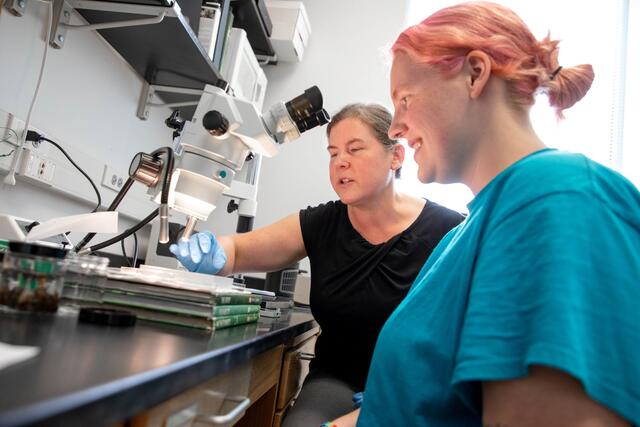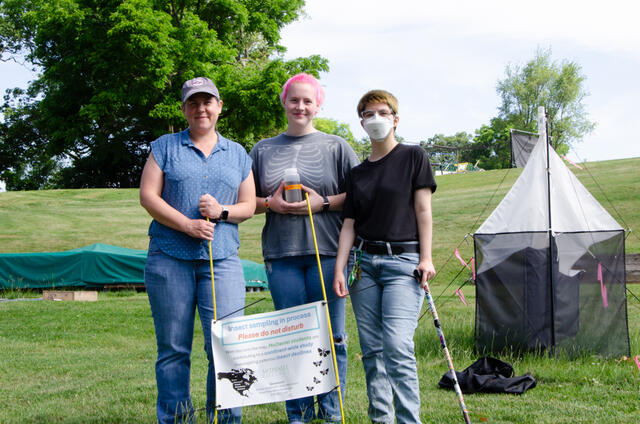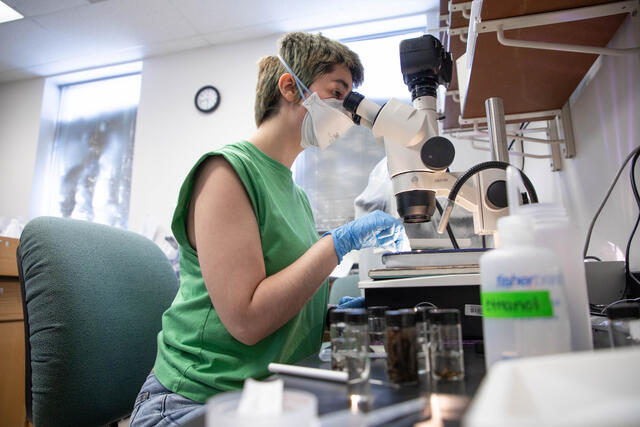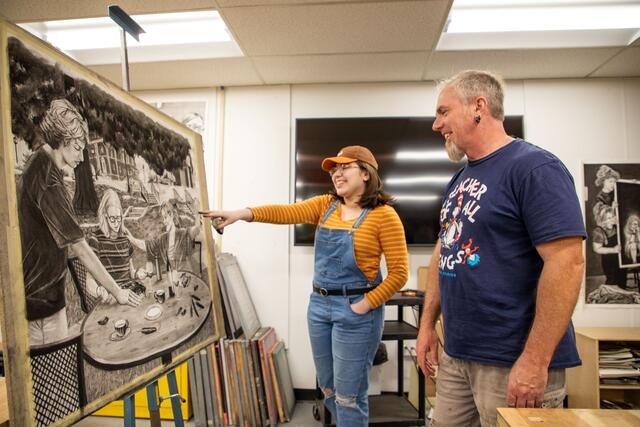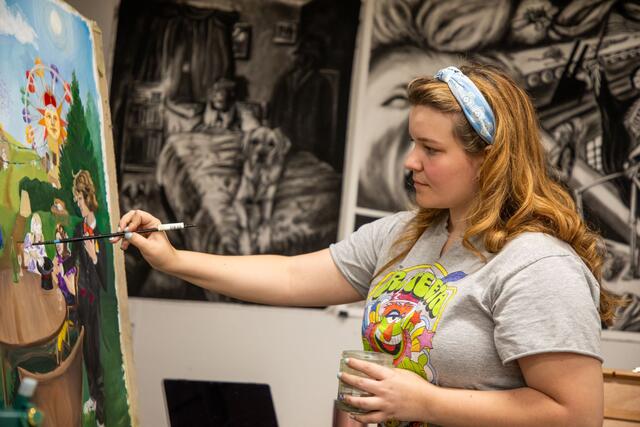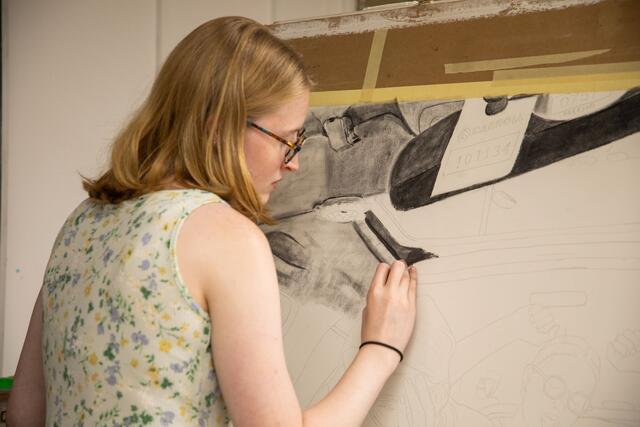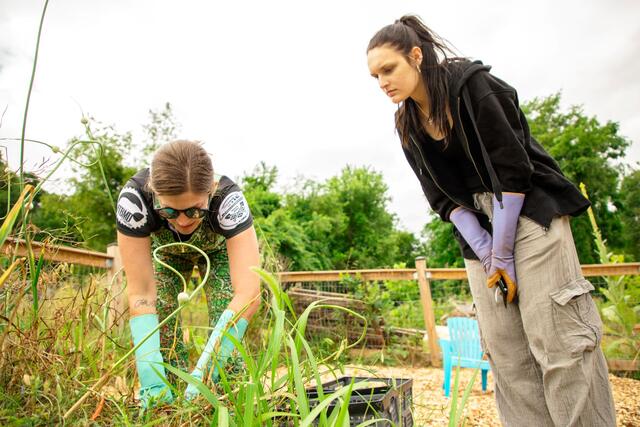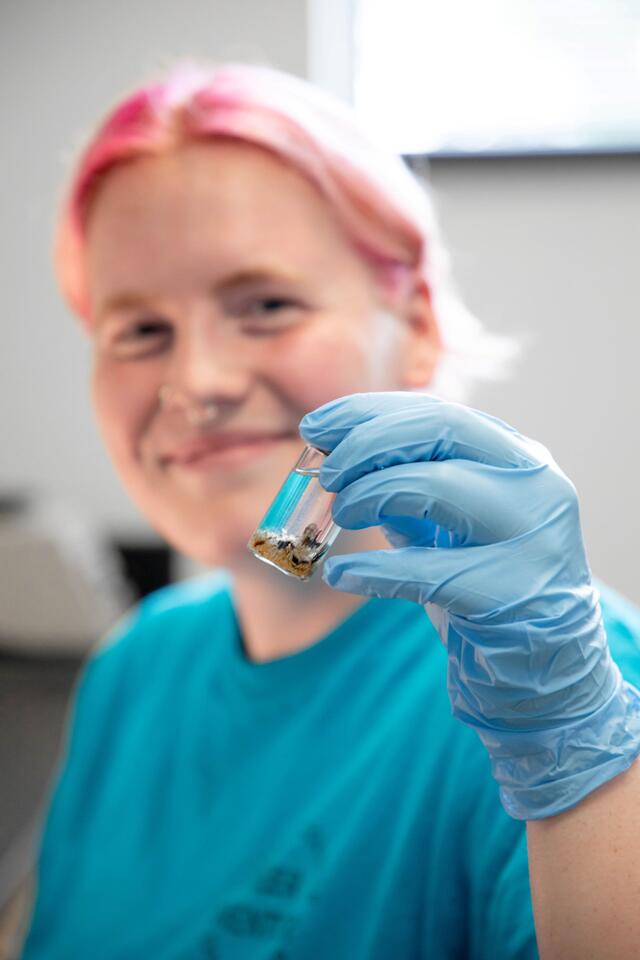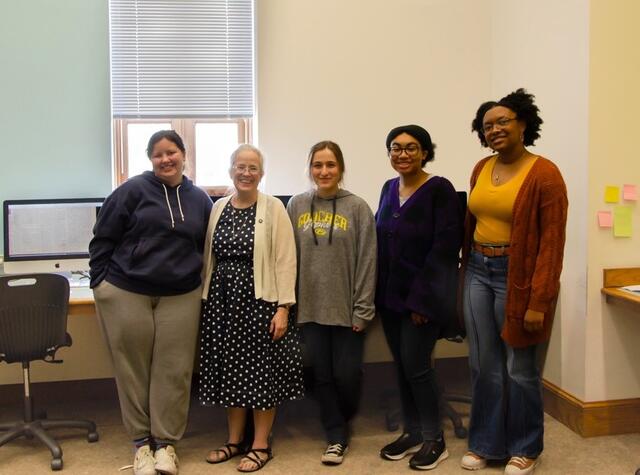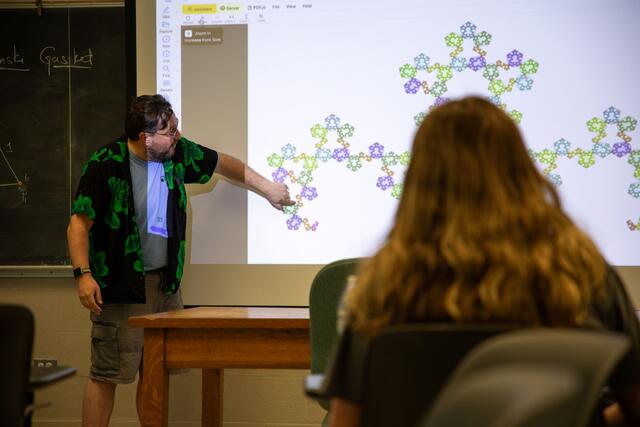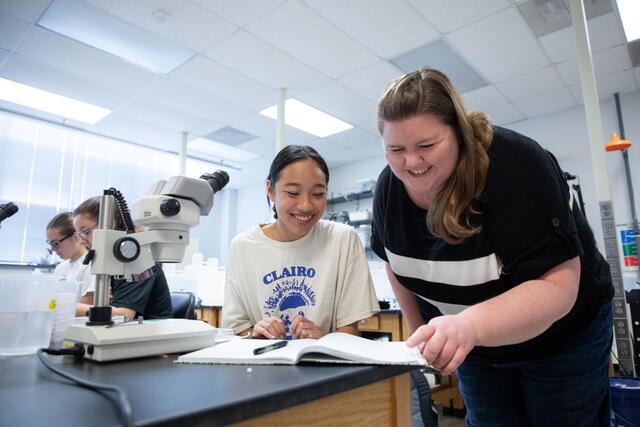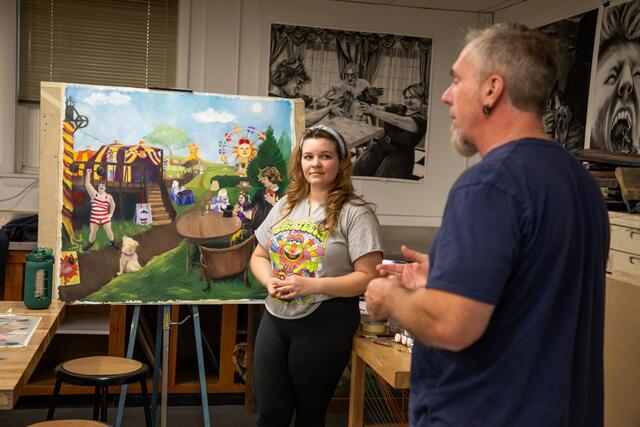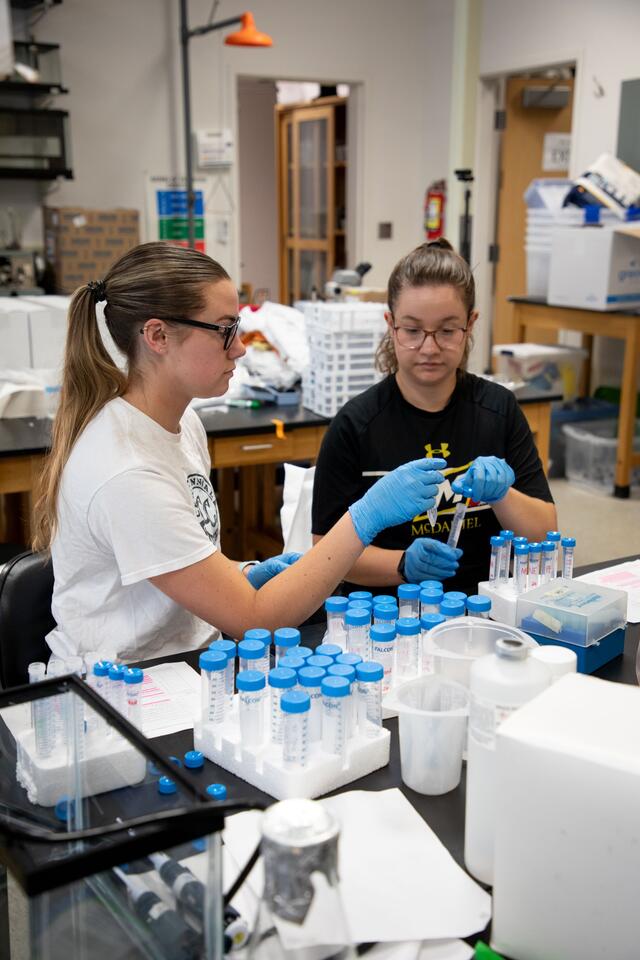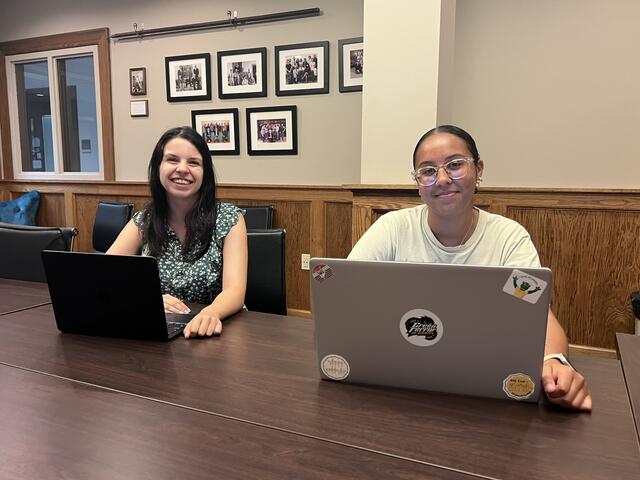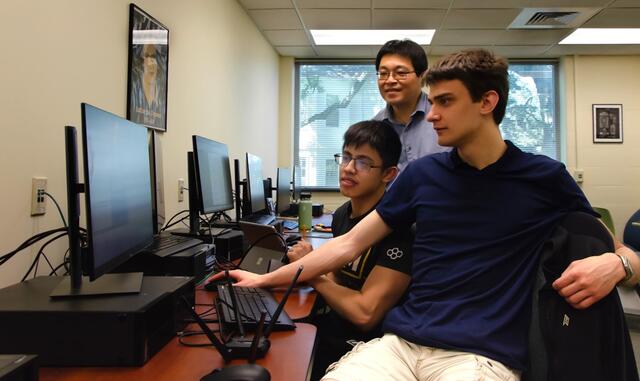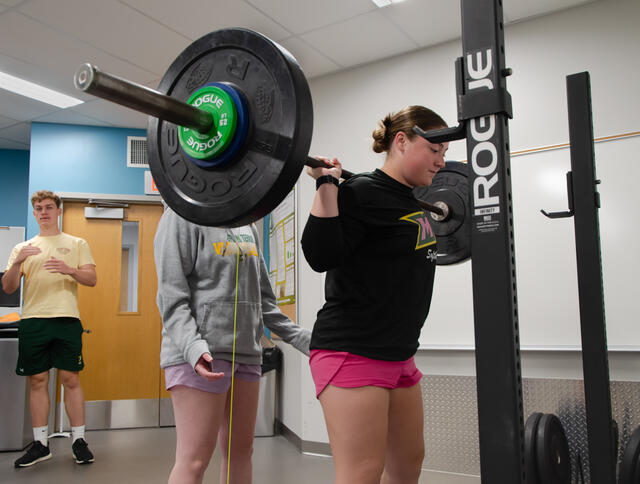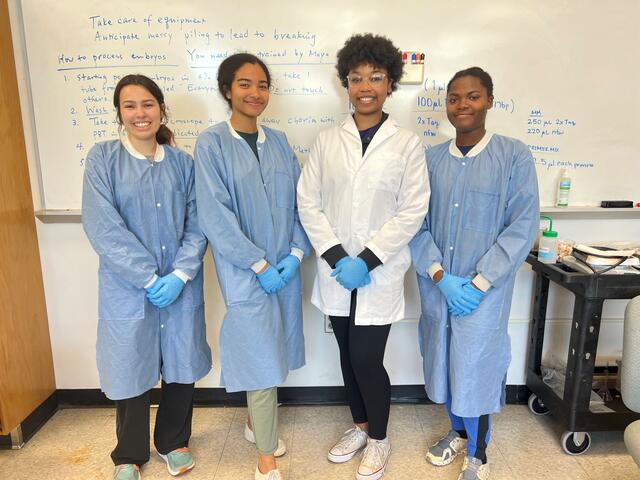Students support global and local communities in the Student-Faculty Collaborative Summer Research Program
Every summer, McDaniel students make strides in their academic and professional savvy with the donor-funded Student-Faculty Collaborative Summer Research Program. By engaging with pressing issues — like contributing data to a global study on insect declines or surveying Maryland high school educators about current challenges — they gain skills that serve their communities now and in the future.
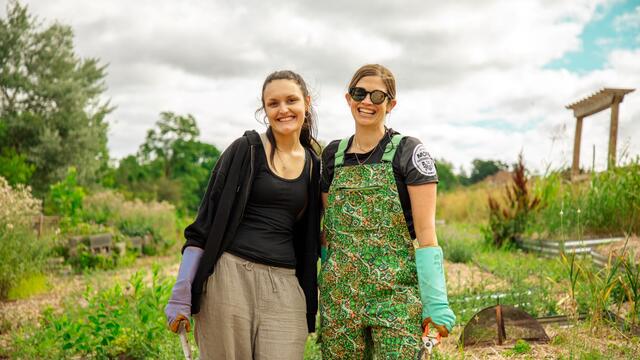
This summer, Associate Professor Chloe Irla '07 and rising junior Graphic Design major Lily Coburn spent time maintaining and photographing the Shafer Forest Garden at the McDaniel Environmental Center. Their outdoor efforts supported a study on biophilic design for campus spaces.
During the eight-week donor-funded Student-Faculty Collaborative Summer Research Program, McDaniel College students venture into new terrain with intensive research. Part of the McDaniel Commitment, research allows interested students to prepare for upper-level courses, graduate school, and their careers.
This summer, nearly 20 professors have been leading projects in a variety of subjects, including Art, Political Science, Biology, Social Work, Chemistry, English, Math, and Computer Science with over 50 undergraduate students.
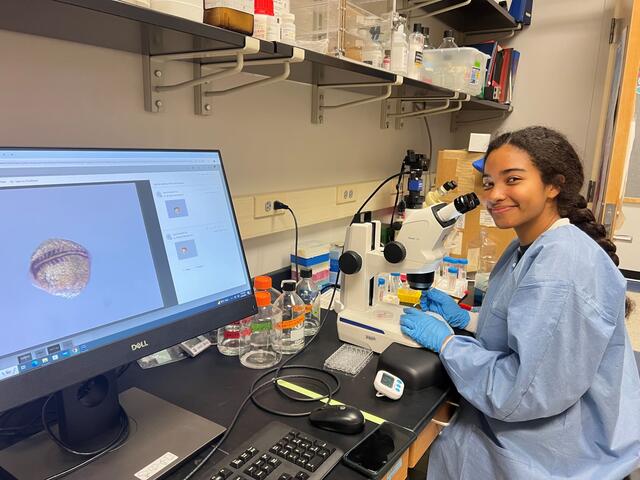
Junior Biochemistry major Ingrid Mandala Kol researched gene expression this summer in Associate Professor Cheng Huang's lab.
The donor-supported program provides an opportunity for students to take their research beyond the classroom. Many of the projects result in national conference presentations, art exhibitions, publication, and capstone projects.
Three groups of students spent the summer researching in the campus Biology labs. In Associate Professor Cheng Huang’s lab, students collaborated on research that explores gene expression through the molecular cloning of neurexin cDNAs in zebrafish.

Molecular Biology major Nakayla Lawson has conducted research during every summer of her undergraduate career at McDaniel College.
Junior Biology major Maya Valdez appreciated the independence she had while researching at McDaniel.
“I’m learning a lot from this experience because I get to do most of the thinking and the actual hands-on work myself,” she says.
Another student in the Huang lab, Molecular Biology and Spanish major Nakayla Lawson, has found her college courses enhanced by her undergraduate research — and vice versa. “My college experience and summer research experiences on campus go hand in hand,” Lawson says. “I’ve been doing research since my first year, so I’ve done three summers of research. My classes provided background, and the actual research itself helps with lab during the year.”
“The research process can be difficult, but it’s really interesting and rewarding to make mistakes, learn, change, and ask questions,” adds junior Biochemistry major Ingrid Mandala Kol Mandala Kol. “The process of finding answers to your questions through research and learning how to troubleshoot has caused a lot of growth for me."
In Associate Professor of Biology Holly Martinson’s lab, junior Biology major Madison Wojcik and senior Biology major Bee Forest-Russell used Malaise traps on campus and at the McDaniel Environmental Center to assess insect population trends.
“There’s a lot of worry in the research community about insect and biodiversity declines,” Martinson says. This is the first year McDaniel faculty and students are contributing research to a global project on insect biodiversity, called the North American Insect Abundance Network.
“The data goes toward a bigger picture than an individual could create on their own,” Martinson says.
A major part of the project includes sorting insect samples beneath a microscope. “My favorite part of the research has been seeing what insects look like up close,” Wojcik says.
Students working with Assistant Professor of Biology Allison Kerwin are researching pesticide effects on polyps of the upside-down jellyfish, funded by Kerwin’s National Science Foundation grant.
“Almost every student that wants to do research at McDaniel College gets to. That’s not always possible at larger schools. Here, they also get to work directly with faculty and to learn from each other,” Kerwin says.
For rising senior and Biology major Ngwing Taku, research is a new experience, but a valuable one. “I’ve learned a lot, and I’ll be able to take it into my last few classes of college,” she says.
Rising junior Patty Punchasutthi has plans to one day become a physician assistant or attend medical school, so her time in Kerwin’s lab supports her career goals.
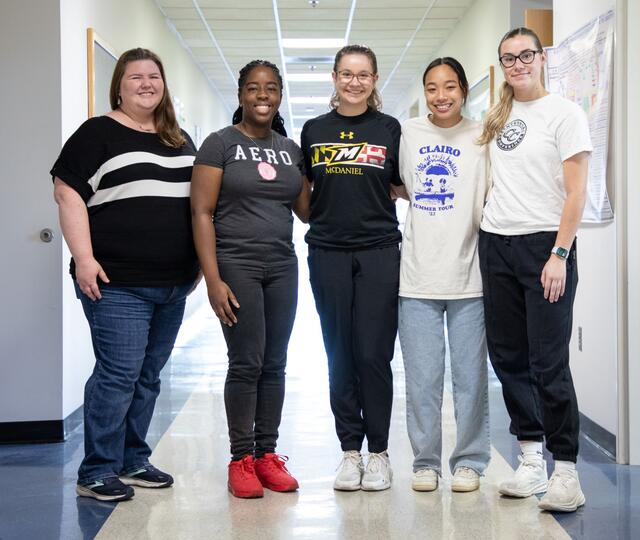
Assistant Professor Kerwin with student-researchers Ngwing Taku, Mackenzie McCarter, Patty Punchasutthi, and Angalyn Strouse.
“We’ll be able to use the methods that we’re learning now in future labs,” Punchasutthi says. “Being able to work in a team environment and communicate with everyone is going to help me in the future, too.”
Art students under the mentorship of Professor Steven Pearson and Associate Professor Chloe Irla '07 dove into unique aspects of art this summer.
Irla and her student collaborator, rising junior and Graphic Design major Lily Coburn, conducted projects on biophilic design, which combines elements of the environment with interior design, and environmental well-being.
Coburn and Irla, who is a master gardener of Carroll County, maintained the Shafer Forest Garden at the McDaniel Environmental Center. While doing so, they photographed the garden and considered how to bring elements of it to indoor campus spaces.
“I’m really excited about the biophilia project, because I want to explore interior design in my career,” Coburn says.
In the Art Studio, Pearson’s students explored narrative figurative art and American realism by creating a series of large-scale artworks that will culminate in a campus exhibition.
Art major Gillian Girod honed her skills in storytelling this summer, particularly useful for the rising senior’s career goals of becoming an illustrator. Her paintings centered around folk art. “It’s extensive research and readings, and knowing how to convey narratives, which can be challenging,” Girod says.
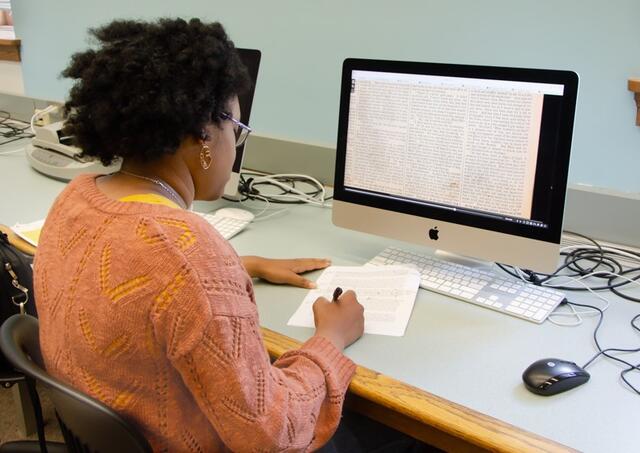
Writing and Publishing major Kayla Douglas conducted research for the first time with the Westminster Detective Library.
“I’ve been learning a lot about environment and place, how to put it into a piece, and what kind of messages you can get out of it,” says Sarah Watson, a rising senior Art major.
Four students contributed to ongoing research for the Westminster Detective Library, with support from English Professor Mary Bendel-Simso. Since its founding in 2008, over 40 students have worked to expand the database, which now hosts stories from more than 350 authors.
“I’ve become more detail-oriented and learned how to find stories more effectively, as well as how to post them in the digital database,” says Kayla Douglas, who is a rising junior Writing and Publishing major. “I love looking into newspaper archives to find how stories have been renamed and republished in different newspapers over time.”
“Seeing the writing from different time periods is like touching a piece of history,” adds Caroline Willis, a rising junior majoring in English and Communication.
Students collaborating with English Lecturer Alexander Champoux-Crowley — rising junior Grace Hill and rising junior Marley Wilson — began surveying individuals employed in secondary education. Hill, an Accounting and Theatre Arts major, is investigating challenges in funding high school theatre programs. Wilson, who is an American Sign Language major, is investigating perceptions on ASL interpretation service offerings in high schools. Read more about their project.
Rising senior and Social Work major Nicki James collaborated with Social Work Professor Jim Kunz to research and assess the feasibility of conducting a local advocacy campaign to rename Col. Rosser Lane in Westminster, Maryland. The street was named after Confederate Major General Thomas L. Rosser, who led a raid of Westminster in 1862.
“I have really enjoyed learning about Civil War history in Westminster, as well as the history of local businesses and buildings,” James says. “I’m looking forward to sharing what I have learned through the Academic Symposium next year!”
In the discipline of Kinesiology, Professor Jennifer McKenzie '01 and Associate Professor Richard Laird collaborated with students to study how accurately people predict the number of repetitions (reps) they can do before they reach failure in an exercise.
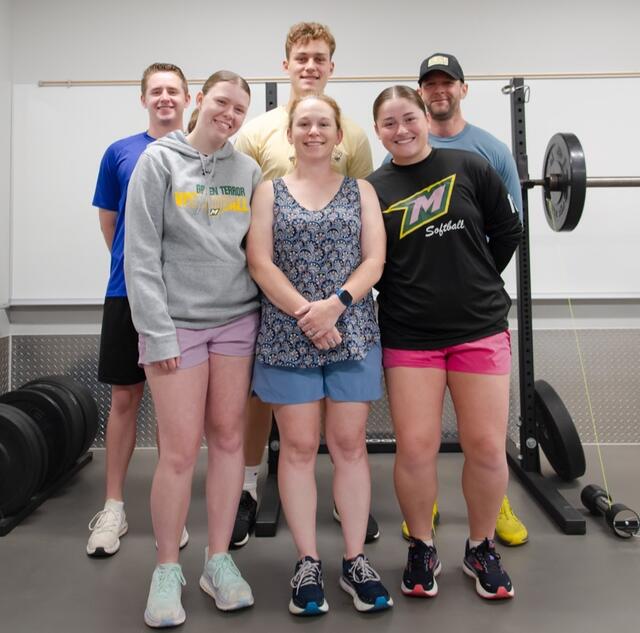
Summer Kinesiology research by Chase Hood, Todd Calhoun, Associate Professor Laird (back row), Samantha Fadel, Professor McKenzie, and Jess Millard (front row) contributes to future research studies in their department. Photo by McDaniel student Nicki James.
Over multiple semesters, the researchers have found that people underestimate their reps in reserve by roughly seven when they claim they’re five reps from failure. So, when they call five, they can usually manage to do 12 more.
“We’ve looked at a variety of factors that might impact that accuracy,” says Laird, including types of athletes, gender, amount of training, and prescribed rests.
This summer, the team implemented a Tendo unit to measure velocity. “The Tendo unit is set at two points of velocity and if you go over, it’ll make a high beep, but if you’re under it’ll be a low beep,” says Todd Calhoun, sophomore Kinesiology major.
Computer Science major Corey King has been creating a digital library with mentorship from Associate Professor of Computer Science Ting Zhang. Using HTML, Javascript, and Python, King and three other students began building a database for tiehua artwork — Chinese wrought iron art.
“This is the first time I’ve done research, but since doing this, I’ve made my own weather website on my free time to add to my resume,” says King. The students involved this summer have all taken Zhang’s Database Design course.
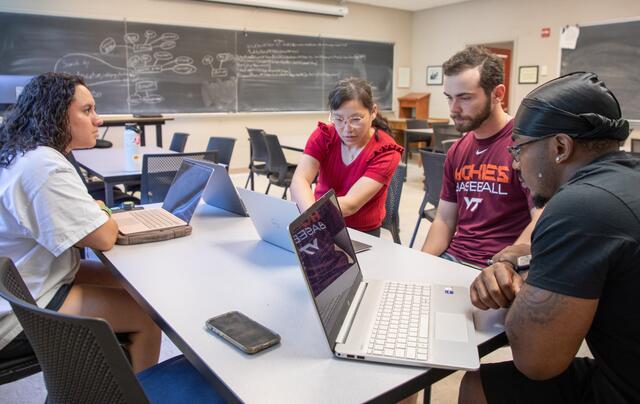
Katherine Martinez, professor Ting Zhang, Tyler Perry, and Corey King (l.-r.) consult on the creation of their new database.
Zhang got the idea for the project from McDaniel History Professor Qin Fang. Fang’s own previous student-faculty research included gathering data on tiehua art, which is now in need of a fresh digital library.
Computer Science majors Liam Estell and Romeo Tsai worked with Associate Professor of Computer Science Paul Lin to create software that could monitor online activity from a home Internet router.
“Doing the network capturing is the most interesting part, because when we pull up the application, we get every single network packet that’s sent and we can attempt to parse data out of it,” Estell says.
The group plans to attend a conference in the upcoming months with the results of their research.
Applied Mathematics major and rising sophomore Ellie Riggs collaborated on a student-faculty project that first began at McDaniel in 2015. She worked on fractal geometry with Benjamin Steinhurst, associate professor of Mathematics.
“I’ve learned how in research, the answers are not definite. You have to go out and search for the answers,” Riggs says.
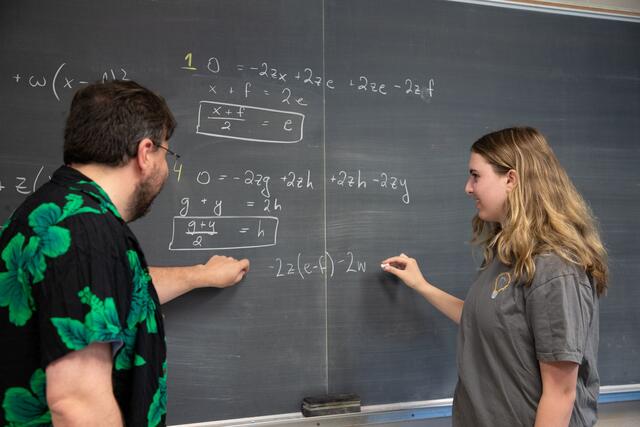
Professor Benjamin Steinhurst and Ellie Riggs worked on fractal geometry this summer.
Learn more about the research projects this summer:
- Dana Ferraris, professor of Chemistry, collaborated on research for an ongoing project covering the design, synthesis, and evaluation of inhibitors of the SARS-CoV2 Macrodomain (Mac1), with students Alex Ratnakar of Woodstock, Maryland; Hira Khan of Littlestown, Pennsylvania; and Cody Neils of Silver Spring, Maryland.
- Peter Craig, associate professor of Chemistry, worked on research on transition metal medicinals with students Isabella Mitchell of Eldersburg, Maryland; Declan Hartman of Bethesda, Maryland; Brooke Rybacki of Salisbury, Maryland; Katie Frank of Ellicott City, Maryland; Tim Clark of Westminster, Maryland; and Amanda Thompson of Media, Pennsylvania.
- Stephanie Homan, assistant professor of Chemistry, collaborated on a project studying ultrafast electron and energy transfer dynamics in Schiff base compounds with student-built laser instrument with students Emily Pozsgay of Keedysville, Maryland, and Emily Goodfellow of New Freedom, Pennsylvania.
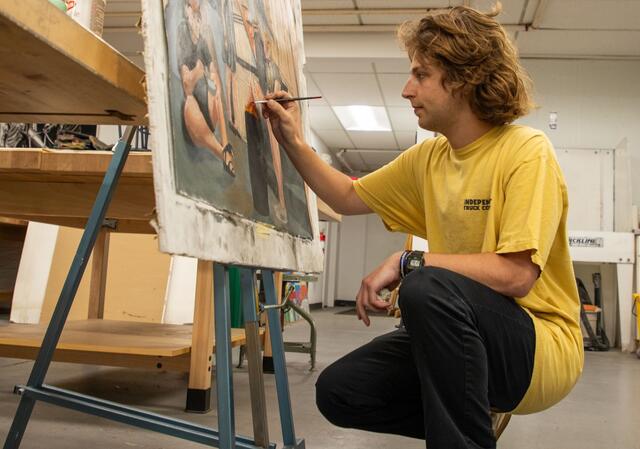
"It's nice to try new things, experiment, and learn. This research has been a great opportunity to see how other people approach art and to have other artists to work along with," says Evan Meyers '24, who conducted research with Professor Steven Pearson.
- Paul Muhlhauser, associate professor of English, worked on ongoing research called “What’s Your Jock Support,” which explores the intersection of sports and politics. He collaborated with students Emily Hollwedel of Ellicott City, Maryland; Kelly Kujawa of Jessup, Maryland; Danielle Carter of Rockville, Maryland; and Margaret Riekenberg of South Orange, New Jersey. He also collaborated with student Iris Levandoski of Odenton, Maryland, on research titled “Remixing Winter Holidays: Challenging the Santa Clausal Effect.”
- Gretchen McKay, professor of Art History, collaborated with student Sylvan Eichenlaub of Hope, Maine, on “Clash of Gods: How Should Christ be Depicted.”
- Apollo Mian, professor of Physics, collaborated with Batchimeg Adiya on “Investigation of Artificial Opals.”
- Jeff Marx, professor of Physics, worked with student Abdoulie Njie of Upper Marlboro, Maryland, on “Granular Physics Investigations.”
- Farzad Ahmadi, assistant professor of Physics, collaborated with student Oscar Riggins of Kensington, Maryland, on “Phase Change of Droplets in Different Media.”
- Anouar Boukhars, associate professor of Political Science, worked on research examining the role of policing in countering insurgencies with students Sana Askari of Westminster, Maryland, and Kaami Effa of Bowie, Maryland.
- Jim Kunz, professor of Social Work, collaborated on a project titled “Conversion Therapy: Policy and Advocacy Research” with student LJ Maysonet of Silver Spring, Maryland. Kunz also collaborated with student Nicki James of Westminster, Maryland, on “Renaming Confederate Col. Rosser Lane: Exploratory Research.”
- Cheng Huang, associate professor of Biology, worked with Maya Valdez of Elmhurst, Illinois; Nakayla Lawson of Baltimore; Ingrid Mandala Kol of Herndon, Virginia; and Kekeli Womack of Montgomery Village, Maryland, on the molecular cloning of zebrafish neurexin cDNAs.
- Holly Martinson, associate professor of Biology, collaborated with students on assessing insect population trends at McDaniel using Malaise traps. She worked with Madison Wojcik of Halethorpe, Maryland, and Bee Forest-Russell of Virginia Beach, Virginia.
- Allison Kerwin, assistant professor of Biology, collaborated on research studying the effects of insecticides on survival and metamorphosis of the upside-down jellyfish, Cassiopea xamachana, and its symbiotic community with students Mackenzie McCarter of Hagerstown, Maryland; Ngwing Taku of Bowie, Maryland; Angalyn Strouse of Spring Grove, Pennsylvania; and Patty Punchasutthi of Boonsboro, Maryland.
- Richard Laird, associate professor of Kinesiology, and Jennifer McKenzie, professor in Kinesiology, worked on research on the accuracy of self-reported repetitions in reserve as a means of determining individualized training intensity with Jess Millard of Edgewater, Maryland; Chase Hood of Frederick, Maryland; Samantha Fadel of Brooklyn, New York; and Todd Calhoun of Woodbine, Maryland.
- Ting Zhang, associate professor of Computer Science, collaborated on the creation of an online library for tiehua artworks with students Corey King of Ocala, Florida; Tyler Perry of Woodbridge, Virginia; and Katherine Martinez of Brentwood, Maryland.
- Paul Lin, associate professor of Computer Science, worked on “Computer Activity Monitoring and Data Analysis” with students Liam Estell of Ellicott City, Maryland, and Romeo Tsai of Montgomery Village, Maryland.
- Benjamin Steinhurst, associate professor of Mathematics, collaborated on research on recursively drawn fractals with students James Opre of Milford, New Hampshire, and Ellie Riggs of Sykesville, Maryland.
- Chloe Irla, associate professor of Art, worked on research about biophilic design and environmental well-being at McDaniel with time spent at the McDaniel Environmental Center with student Lily Coburn of Germantown, Maryland.
- Steven Pearson, professor of Art, and students Gillian Girod of Westminster, Maryland; Danielle Silva of Gaithersburg, Maryland; Evan Meyers of Westminster, Maryland; and Sarah Watson of York, Pennsylvania, conducted research resulting in artworks in the theme of “Revisiting the Legacy of American Realism in the 21st Century.”
- Mary Bendel-Simso, professor of English, collaborated on the Westminster Detective Library with students Kayla Douglas of Baltimore; Jayla Pickeral of Aquasco, Maryland; Caroline Willis of Cranford, New Jersey; and Eliza Nixon of Phoenix, Maryland.
- Alexander Champoux-Crowley, lecturer in English, collaborated with Grace Hill of Essex, Maryland, on “Understanding Challenges in Funding High School Theatre Programs,” and with Marley Wilson of Westminster, Maryland, on “Perceptions on ASL Interpretation Service Offerings at Secondary Institutions.” Read more.
